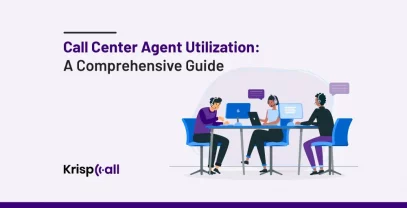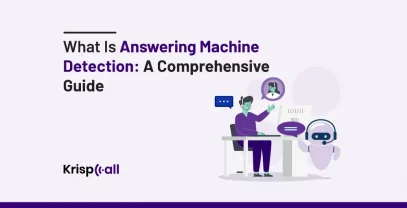Do you want to measure the rate of inbound calls ☎️ over a given period of time and, based on the data, hire staff accordingly? If yes, then calculating the call rate arrival might be your best solution.
Call Arrival Rate helps you determine the peak call hour and seasonal trend. Based on this metric, you can hire staff or train them to handle customers’ calls efficiently.
In this blog post, you’ll dive deeply into the call arrival rate metric, explain why it’s essential, and how you can optimize your call center’s call arrival rate.
🔑KEY HIGHLIGHTS
- Call Arrival Rate (CAR) is a metric that calculates the average incoming call handled by agents at a specific time.
- To calculate the Call Arrival Rate, you need to divide the total number of incoming calls by time period.
- Call Arrival Rate is an essential Key Performance Indicator (KPI) that helps team leaders observe agents’ performance.
- To optimize call arrival rates, you must invest in advanced forecasting techniques, provide staff with proper training, offer a self-service option, and implement call deflection strategies.
- KrispCall provides various features, such as interactive voice response, analytics, monitoring, and recording, to help you efficiently handle many incoming calls.
What is the Call Arrival Rate?
The Call Arrival Rate is a metric that measures the average rate of incoming calls handled within a specific time period. This metric is crucial for understanding the volume of calls a business receives and can be calculated for various time frames, such as minutes, hours, days, weeks, months, and even years. The Call Arrival Rate also tracks how many calls are being handled or are on hold.
The more business received, the higher the call arrival rate is. A high call arrival can boost your company’s sales, especially for businesses relying on phone sales or customer inquiries to convert leads. It also reflects your business as a strong brand recognition and trust, showing that customers view the business as a reliable and preferred choice.
How to Calculate the Call Arrival Rate?
To calculate the call arrival rate of your call center, you need to use the arrival rate formula.
Call arrival rate formula = Number of Calls Received / Time Period.
For example, Let’s say a contact center has to calculate call arrival per minute ⏲️. Before calculating the arrival rate, you need to make sure you choose a time unit in seconds, minutes, or hours and then divide the number of incoming calls by that unit.
Suppose a call center receives 4000 calls in a day. The total number of calls received is 1440 minutes (24 hours x 60 minutes).
Here’s how to calculate the Call Arrival Rate in this case:
Total Time period= 1440 minutes
Total Number of incoming Calls = 4000
We have,
Call arrival rate formula= Number of Calls Received / Time Period
=4000/1440=2.78
Thus, the resulting call arrival rate is 2.78. per minute
To round things up, managers can report that the total call arrival rate for the day is 3 calls per minute.
Why is The Call Arrival Rate Essential?
Call Arrival Rate (CAR) is essential because it measures how frequently customers contact a call center. It directly impacts the quality of customer service and the allocation of resources. Moreover, It ensures timely response, minimizes wait times ⏲️, and improves customer satisfaction.
There are other factors why call arrival rate is essential;
- Customer experience: Call Arrival Rate ensures businesses have the right number of agents to handle incoming calls properly. By accurately predicting call volumes, companies can minimize wait times and reduce the chance of abandoned calls, leading to higher customer satisfaction.
- Workforce optimization: Its data is crucial for planning breaks, shifts, and vacations for call center agents. It ensures the right number of staff are available during active times, boosting productivity, employee satisfaction, and overall workforce efficiency.
- Cost management: Call Arrival Rate helps your business control operational costs. It helps manage staff levels with call volumes; businesses can avoid overstaffing and unnecessary labor costs. This way, accurate CAR measurement can significantly impact your budget.
- Resource allocation: CAR helps businesses determine where to allocate their resources most effectively, whether training more agents or investing in better call-handling technology. It ensures that resources are utilized efficiently while enhancing overall operational effectiveness.
Factors Affecting the Call Arrival Rate Metrics
There are various factors, such as the efficiency of call center agents, call fluctuation volume, and customer segments, that affect the arrival call rate in call centers. Here are some factors that can impact call arrival rates:
Seasonal trends
Seasonal trends such as holidays, weather, events, and school schedules can significantly impact call volume. Many businesses experience various fluctuations throughout the year. For instance, during the holiday shopping season, retail businesses often see a surge in calls as customers inquire about deals, gift ideas, and shipping deadlines.
Customer behavior
Most of the time, call arrival rates are determined by customer behavior. Various factors, such as customer preference, choice, and satisfaction, can affect the overall call volume of business. For example, the call arrival rate might decrease if customers prefer online chat support or self-service options.
Quality of customer service
If the call center provides the best service and knows how to handle calls, it can actually receive many calls. Call volume directly impacts call arrival rates. Customers feel positive when call center agents provide quick and efficient support and problem-solving tips. If their expectations are not met, they might be less likely to call again.
Product or service issues
When a product or service has problems, such as defects, outages, or any issue, customers are likely to call for support. High call volumes show that customers have issues or are dissatisfied with the product or service. Problems with products or services can significantly impact call arrival rates.
Staffing levels
The number of available staff can directly impact the call arrival rate metrics. Insufficient staffing can lead to longer wait times and higher call abandonment rates. On the other hand, well-staffed call centers can handle higher volumes efficiently and reduce the need for repeat calls.
How to Optimize Call Arrival Rate?
Optimizing the call arrival rate involves improving the efficiency and effectiveness of the processes that manage incoming calls. Here are some strategies to optimize call arrival rates:
1. Invest in Advanced Forecasting Techniques
Forecasting predicts future events based on past data and current trends. It analyzes historical data, seasonal trends, and predictive analytics to help businesses predict call volume more accurately.
Call centers can use different advanced forecasting techniques to predict how many calls they might receive or how many agents they need to handle the workload. When call centers predict their call volume, they can match staff levels to increase call efficiency.
2. Staff Training
Training allows employees to become more effective while increasing job satisfaction and reducing employee turnover. So, if your business wants to optimize call arrival rates, you must invest in thorough training programs.
When you train agents, they will learn the required call-handling skills, handle calls more efficiently, and have the knowledge to solve problems quickly and accurately. Moreover, enhancing their call-handling skills will give them access to relevant information and decision-making capabilities.
3. Provide Self-service Option
Self-service allows users to find answers and resolve issues on their own. Call centers should consider providing self-service options such as Interactive Voice Response (IVR) systems, chatbots, and online knowledge bases.
Customers won’t have to call agents for simple questions; they can look into the self-service option themselves. This way, agents can handle more complex queries on a call, resulting in increased efficiency and customer satisfaction.
4. Implement a Strong Quality Assurance Program
The call center should regularly monitor and evaluate how calls are handled. To do so, it must implement a strong quality assurance program. This program involves examining call records, surveying clients, and gathering feedback to identify areas needing improvement.
Call centers can use this information to refine procedures, determine necessary training, and take corrective actions. Continuously using this information can help reduce repeat calls, increase first-call resolution rates, optimize call-handling efficiency, and enhance overall service quality.
5. Implement Call Deflection Strategies
To effectively manage non-urgent inquiries, you need to employ call-deflection strategies to redirect them to other communication channels. For example, customers can be encouraged to use online chat or email for less pressing questions, which will free up phone lines for urgent matters.
Additionally, call centers can provide information through FAQs, instructional videos, or community forums to address common concerns before they call. This strategy will help call centers reduce overall call volume and improve customer service efficiency.
Boost Your Business Success With Your First Few Steps
KrispCall helps call centers effectively manage call arrival rates by providing inbound call center solutions. Its inbound call center solution has several features like call forwarding, call monitoring, Interactive Voice Response, and call analytics, which play a vital role in managing a high volume of incoming calls. No matter how many incoming calls the call center receives with KrispCall call center software, you can handle it properly.
Key features of KrispCall for business:
- Call analytics: KrispCall’s call analytics features provide you an insight into real-time call data, including total call volume, call duration, inbound calls, and outbound calls. This help you identify areas for improvement and provide better training to your customer service team.
- CRM Integration: KrispCall integrates seamlessly with customer relationship management (CRM) systems, equipping agents with caller context for personalized service.
- Call recording and monitoring: With the KrispCall call recording and monitoring feature, you can record all the calls and ensure quality assurance and compliance. You can also monitor calls live and provide immediate feedback to agents.
- Interactive Voice Response: The KrispCall IVR feature guides your caller through a menu and provides direct access to specific information. It also intelligently routes them to appropriate company departments.
Why Choose KrispCall?
These features combine to enhance operational efficiency, improve customer experience, and support business growth. KrispCall empowers call centers to navigate varying call volumes effectively, ensuring every customer interaction is handled with care and expertise.
Take the first step towards enhancing your call center operations with KrispCall’s innovative solutions today.
Conclusion
Optimizing the Call Arrival Rate (CAR) is crucial for call centers that are aiming to enhance customer service efficiency and operational effectiveness. By investing in advanced forecasting techniques, such as predictive analytics, call centers can accurately predict call volumes and adjust staffing levels.
Training staff will help businesses handle calls effectively, reducing call durations and improving customer satisfaction. Implementing self-service options like IVR systems and chatbots will help agents focus on more complex issues. By employing these strategies, call centers optimize their CAR, streamline operations, reduce costs, and ultimately elevate customer experience.
FAQs
What is the arrival rate (calls per minute)?
The arrival rate (calls per minute) means the average number of calls received per minute. Use the Arrival rate formula (Number of Calls Received / Time Period) to calculate the arrival rate in one minute.
What do you mean by a good arrival rate?
A good Call Arrival Rate (CAR) means that agents are efficiently handling calls and minimizing the wait times for customers.
Why is the service rate greater than the arrival rate?
The service rate is higher than the arrival rate in order to maintain efficient operations within a system, such as a call center or a queue management scenario. For instance, if the service rate (the rate at which services or calls are handled) is higher than the arrival rate (the rate at which new requests or calls arrive), it ensures that the system can keep up with incoming demand without creating excessive waiting times. But, if the arrival rate is greater than the service rate, it will lead to a growing queue and longer waiting times in the short and long term.





